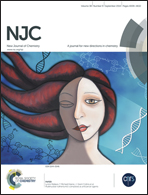A label-free conjugated polymer-based fluorescence assay for the determination of adenosine triphosphate and alkaline phosphatase†
Abstract
In this paper, a simple, sensitive, label-free fluorescence sensor for the detection of adenosine triphosphate and alkaline phosphatase was developed, which was based on the water-soluble fluorescent conjugated polymer. Cu2+ could efficiently quench the photoluminescence (PL) intensity of fluorescent conjugated polymer PPESO3 due to the strong electrostatic interaction and electron transfer between PPESO3 and Cu2+. However, the addition of adenosine triphosphate (ATP) could disrupt the polymer–metal complex, leading to the recovery of the fluorescence of PPESO3. The PL intensity ratio I/I0 (I0 and I are the fluorescence intensity of the PPESO3–Cu2+ system in the absence and the presence of ATP, respectively) was proportional to the concentration of ATP. The proposed method was successfully applied to the detection of ATP in human serum samples with satisfactory results. Moreover, considering that ATP could be hydrolyzed by alkaline phosphatase (ALP) and the released Cu2+ could quench the fluorescence of PPESO3, the enzyme activity of ALP was also studied.


 Please wait while we load your content...
Please wait while we load your content...